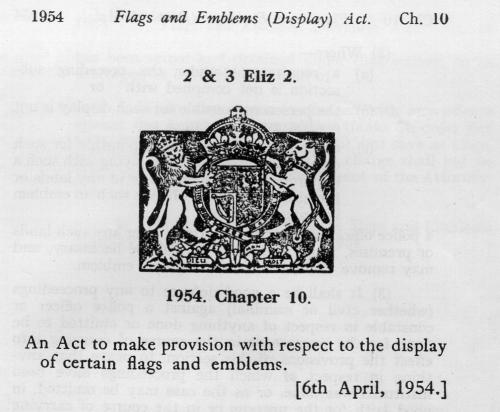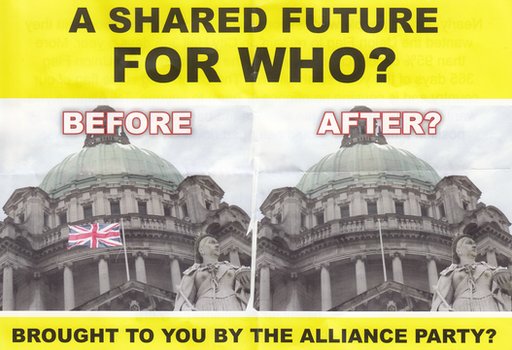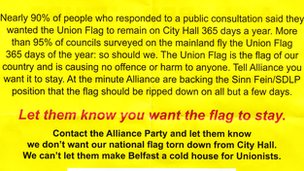
CAIN Web Service
Note on the protests related to the Union Flag at Belfast City Hall, December 2012 - January 2013
Page Compiled: Martin Melaugh [last update: 8 Feburary 2013]
Material is added to this site on a regular basis - information on this page may change
A background note on the protests and violence related to the Union Flag at Belfast City Hall, December 2012 - January 2013
Introduction
Northern Ireland is experiencing a period of sustained street protests by loyalists who oppose the decision taken by Belfast City Council to only fly the Union Flag on Belfast City Hall on a number of designated days each year (mainly royal birthdays). Previously the flag had flown 365 days each year. Most of the protests involve the blocking of main roads and the picketing of the offices of the Alliance Party of Northern Ireland (APNI). During December 2012 some of the protests turned violent and one APNI office was completely destroyed and a number of others damaged. Some APNI elected representatives had their homes attacked. One APNI MP received a death threat. During January 2013 many more public representatives have received loyalist death threats and rioting has accompanied many of the street protests.
The following information is intended for people from outside Northern Ireland who may not fully understand the background to the controversy surrounding the flying of the Union Flag at Belfast City Hall.
Historical background:
- The Plantation of Ulster, in the early 17th century, saw the policy of encouraging people from Scotland and England to settle in the north-east of Ireland on land that had been confiscated from the native Irish. These ‘Planters’ were Protestant and had strong cultural ties with England and Scotland. The native Irish were Catholic.
- Thus Northern Ireland has two main distinct communities, one (mainly Protestant) which views itself as British and overwhelming supports the continuation of the union with Britain. The other (mainly Catholic) sees itself as Irish and a majority of which would like to see the re-unification of Ireland.
Background information on flags and emblems:
-
Symbols remain an important way of expressing political allegiance in Northern Ireland. Each community has its own set of, mutually exclusive, emblems. Flags are one manifestation of this difference with unionists/loyalists adopting the Union flag (Union Jack) of the United Kingdom, and nationalists/republicans displaying the Tricolour of the Republic of Ireland.
- Flags and other emblems have been used to mark out territory in Northern Ireland. They are also waved in the faces of opponents at times of confrontation. The symbols of each community are regularly damaged in attacks.
- The British Union Flag is the official flag of the United Kingdom (of Great Britain and Northern Ireland); see note on flags.
- The main public displays of unionist and loyalist culture is through loyal order parades and the use of symbols. The British Union flag is the best known of the emblems used. It is used by unionists and loyalists to reinforce their British identity.
- Nationalists and republicans express their identity through Irish culture (language, music, sport, etc.) and also adopt Irish emblems. The best known flag being the Irish tricolour
- The Unionist Party held complete power at Stormont between 1921 and 1972. In 1953 the ‘Ulster Banner’ was adopted as the flag of Northern Ireland. Following the Northern Ireland Constitution Act 1973 this flag ceased to have any official standing.
 The Stormont Parliament passed the Flags and Emblems (Display) Act (Northern Ireland) 1954. This act made it a criminal offence to interfere with the flying of the Union Flag. It also gave RUC officers the power to remove any other flag that was likely to cause a breach of the peace. This clause was only ever used against the Irish Tricolour. The Flags and Emblems act was repealed by the Public Order (Northern Ireland) Order 1987, which was introduced by British Direct Rule ministers. The Stormont Parliament passed the Flags and Emblems (Display) Act (Northern Ireland) 1954. This act made it a criminal offence to interfere with the flying of the Union Flag. It also gave RUC officers the power to remove any other flag that was likely to cause a breach of the peace. This clause was only ever used against the Irish Tricolour. The Flags and Emblems act was repealed by the Public Order (Northern Ireland) Order 1987, which was introduced by British Direct Rule ministers.- The Good Friday Agreement (/The Belfast Agreement) contains one clause related to symbols / emblems:
"5. All participants acknowledge the sensitivity of the use of symbols and emblems for public purposes, and the need in particular in creating the new institutions to ensure that such symbols and emblems are used in a manner which promotes mutual respect rather than division. Arrangements will be made to monitor this issue and consider what action might be required."
Northern Ireland Office (NIO). (1998). The Agreement, Text of the Agreement reached in the Multi-Party Negotiations on Northern Ireland, (10 April 1998), (Cmnd. 3883), [Good Friday Agreement; Belfast Agreement].. Belfast: HMSO. ... [3083]
Political Background:
- On 6 May 2010, at the Westminster Election, Naomi Long (Alliance Party of Northern Ireland; APNI) won the East Belfast seat to become MP for the area. She defeated Peter Robinson, the former MP, leader of the Democratic Unionist Party (DUP), and First Minister. This was the most surprising result of the election and a blow to the prestige of the DUP. The DUP were very anxious to win back this seat.
- Political commentators believed that Long managed to attract significant numbers of former unionist voters.
- It is likely that Robinson’s support suffered due to allegations of financial impropriety surrounding business associations and also the extent of his family's political expenses.
- Some commentators believed that the DUP had been looking for an issue which would allow them to attempt to reduce the support for the Alliance Party among former unionist voters.
Background information on the dispute about the flag at Belfast City Hall:
- In the Local Government Elections on 5 May 2011, Sinn Féin became the largest party on Belfast City Council. The APNI held the balance of power between nationalists / republicans and unionists / loyalists.
- Sinn Féin proposed a motion to remove the Union Flag from flying over Belfast City Hall. Unionists and loyalists wanted to see the flag fly for 365 days a year (as had been the case for many years). The APNI offered a compromise motion that the Union Flag should only fly on 18 designated days each year (mainly royal birthdays) The policy of flying the union flag on designated days was already the policy of some unionist controlled councils in Northern Ireland, it is the policy at parliament buildings in Stormont, and it is the policy at many public buildings throughout the UK.
- In the weeks before the vote on the flag issue, the DUP printed and distributed over 40,000 leaflets, mainly in East Belfast, made out in Alliance Party colours, calling on people to protest about the Alliance proposal. The Ulster Unionist Party (UUP) assisted the DUP in distributing the leaflets.
Leaflet distributed by the DUP and UUP
 |
 |
- The vote on the issue of the flag was taken at a Belfast City Council meeting on Monday 3 December 2012. The democratic vote was in favour of the Alliance Party motion to fly the flag on designated days.
- Outside the City Hall a large group of loyalists, mainly from East Belfast, had gathered to protest in favour of keeping the flag flying 365 days each year. Five police officers and two security guards were injured during rioting that erupted following news about the outcome of the vote. Property was also damaged.
Aftermath of the vote on the flying of the Union Flag:
- Since 3 December 2012, there have been on-going loyalist protests, involving pickets outside Alliance Party offices, and the blocking of main roads. Once Alliance Party office was completely destroyed in an arson attack, others have been damaged. The homes of Alliance Party members have been attacked and damaged. There has been rioting and vehicles have been attacked.
- Rioting has taken place on a regular basis following flag protests. There were six consecutive nights of rioting in East Belfast (up to 9 January 2013). 107 people have been arrested during disturbances and 82 have been charged (up to 9 January 2013). The number of arrests increased to 174 (by 22 January 2013). Approximately 146 police officers had been injured (up to 7 February 2013).
- The Police Service of Northern Ireland (PSNI) stated that policing the protests and dealing with the rioting, over the first nine weeks, has cost the police £15.6 million (up to 4 February 2013). (Previously, the cost of policing the flag protests had been estimated at £7 million - up to 9 January 2013.)
- The Confederation of British Industry (CBI) estimated that the flag protests had cost businesses in Belfast up to £15 million in lost trade (up to 9 January 2013).
- The PSNI has stated that it believes individual loyalist paramilitaries, in particular members of the Ulster Volunteer Force (UVF) in East Belfast, have been involved in the disturbances.
- It was announced on 7 December 2012 that Naomi Long, the Alliance Party MP for East Belfast, had received a death threat. Since then many public representatives have received death threats. Bullets and death notices have been posted by loyalists to Social Democratic and Labour Party (SDLP) members and Sinn Féin members.
- During the early phase of the protests the PSNI indicated that they were trying to facilitate peaceful protests. However, even the peaceful protests involved, and continue to involve, the illegal blocking of roads and pedestrian footpaths, and those taking part often were involved in illegal parades to and from the protest rally (i.e., no notification is given to the Parades Commission).
- Those organising the protests have used Facebook to announce arrangements for street protests in various parts of Northern Ireland. Many of the comments left on the site have been of a sectarian nature. It was reported that death threats have also been made (Irish News, 3 January 2013; front page). The report also indicated that the police had taken no action against anyone posting threating messages on the Web.
- Since the protests began, thousands of Union Flags have been placed in public spaces across Northern Ireland. They have also been erected at interface areas and outside Catholic churces and schools.
- On Wednesday 9 January 2013 the Union Flag was raised over Belfast City Hall on the first of the 18 designated days each year when the flag is due to be flown.
List of source material:
See also:
- Section on Symbols Used in Northern Ireland
- UK Supreme Court ruling (1 Feb 2017) on police handling of illegal flag parages:
- The Supreme Court. (2017). Judgement: DB (Appellant) v Chief Constable of the Police Service of Northern Ireland (Respondent) (Northern Ireland), (2017 UKSC 7; on appeal from 2014 NICA 56), (1 February 2017; heard on 15 November 2016), [PDF; 310KB]. London: TSC. ... [21074]
- The Supreme Court. (2017). Press Summary: DB (Appellant) v Chief Constable of the Police Service of Northern Ireland (Respondent) (Northern Ireland), (2017 UKSC 7; on appeal from 2014 NICA 56), (1 February 2017), [PDF; 137KB]. London: TSC. ... [21075]
|

 The Stormont Parliament passed the
The Stormont Parliament passed the 
